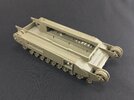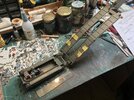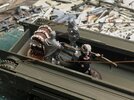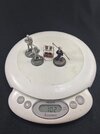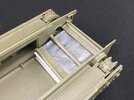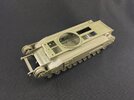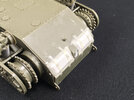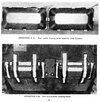With the suspension arm frames built, I could add them to the sponsons, as described above:
View attachment 477594
As I mentioned above, these are not that easy to fit, not only because the arms get in the way but also because the springs push the frames out of line. Best is to start at one end and glue the frame to the sponson there, then slowly work your way to the other end, though you will frequently have to go back and forth a bit to get everything lined out correctly.
Notice I left out the springs for wheels 7 and 8. This is because, as the photo of a real tank in an earlier post already appears to show, those actually extend down instead of being sprung in. From that photo, I worked out the distance between the frame and the top of the wheel for wheels No. 2 and 8, the frontmost and rearmost ones actually on the ground when carrying the bridge. This was not too hard to do by measuring the wheel diameter and the distance to the frame, because the kit’s wheel diameter is a given so it’s just a matter of dividing the gap by the wheel diameter in the photo and multiplying by the kit wheel diameter to find the size of the gap there should be on the model. And since the model will be on level ground, all the wheels between 2 and 8 just need to line up straight with them.
There is a big stroke of luck in all of this. I worked out that wheel 2 needs an 0.75 mm gap while wheel 8 needs a 4 mm gap; springing in the front wheel by 2 mm achieves just that, while the rear one needs to be extended downward as far as the wheel arm (not the spring rod) will let it. That is a downward travel of 1 mm, meaning the total difference between the two wheels is 3 mm — and with seven arms, that means steps of exactly 0.5 mm, which is really easy to do with standard sizes of plastic card

I modified the rods for wheels 7 and 8 by cutting off their heads:
View attachment 477596
Unmodified on the left, cut-down on the right, Note that I didn’t cut through the rod, but trimmed off the flanges to approximately the rod’s diameter, effectively making it longer and allowing it to sit further down than normal.
Then, it was a matter of installing scraps of plastic card of the correct thicknesses as spacers between the sponson bottoms and the heads of the spring rods:
View attachment 477597
Begin by adding a wheel to the arm/rod, else they will go out of alignment. After that you can easily enough stick a bit of plastic card under the front and rear of the rod’s head using tweezers and/or something you can push the spacer around with. As soon as I had one of them correct, I glued the whole thing together: blocks to the sponson and the rod head, wheel to arm and rod, arm pivots, etc.
| Wheel station | Spacer thickness |
|---|
| 2 | 2 mm |
| 3 | 1.5 mm |
| 4 | 1 mm |
| 5 | 0.5 mm |
| 6 | none |
With those in place, I put in wheel 8 (skipping 7 for now), pushing it down as far as it would go and also glueing it in place. Wheel 7 can then be lined up easily by putting a ruler over all the arms and pushing 7 down so it hits the ruler, then glueing it in place as well.
That done, the model sits like this:
View attachment 477598
Also notice I installed sprue struts inside the sponsons. These serve to transfer the model’s weight directly onto the spring arms, instead of trusting in the glue to hold. I wouldn’t do this for other Churchills, but with the bridge and the counterweight that will eventually rest on these wheels, I don’t want the model to perhaps eventually break through its suspension.
 ). With the suspension done, for example, the rest of the hull can be built pretty quickly:
). With the suspension done, for example, the rest of the hull can be built pretty quickly: